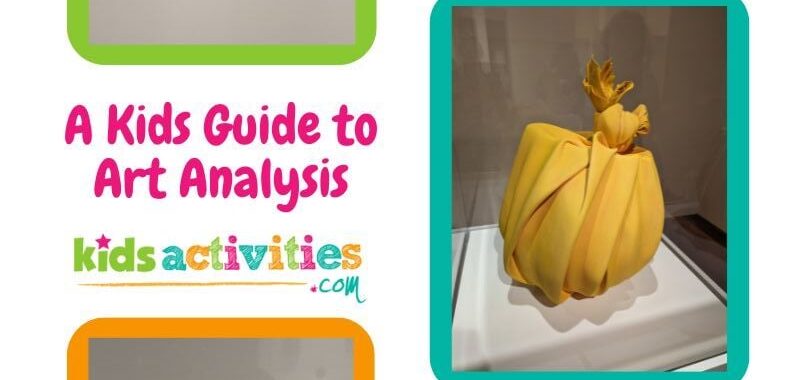Today we are virtually visiting the Dallas Museum of Art together and seeing how kids can apply art analysis to some of our favorite art pieces. Watch the art elements video and play along with adding your own opinions to this art analysis lesson at home or in the classroom!
What is the meaning of art?
Watch this art analysis video lesson for kids and look at some art from the Dallas Museum of Art for a lesson on art analysis and learn how to understand the hidden meanings and clues hidden in artwork, just like a detective!
But first! What is Art Analysis?
Art Analysis, or a “Formal analysis is an important technique for organizing visual information. In other words, it is a strategy used to translate what you see into written words.”
– The Kennedy Center
The four parts of Art analysis
Before watching the video lesson for kids we need to know the different parts of art analysis. Art. There are 4 main parts; physical properties, form, subject matter, and context.
- Physical properties are the physical things that make up the artwork. This can include material, size, shape, and how it was made.
- Form is the elements that make up the art. This includes lines, shapes, colors, textures, and more.
- Subject matter is the meaning or story of the artwork. Most artwork has a story, meaning, symbolism, or important message.
- Context is the history of the artwork. Context can also be the purpose of the artwork, how it was used, or why it was made by the artists.
Now let’s explore some examples from the Dallas Museum of Art! Before watching the video, try analyzing the art you see below!

What can you analyze in this mural?
1: Physical properties
To understand physical properties in art, focus on the materials the artist used, and how they used them. For example, look at Tanaka Yu’s “Tsutsumimono.” It looks like it’s something that’s wrapped in a bright yellow cloth, right? But surprise! It’s actually a clay sculpture! Cool, huh? What else can you tell about this art by looking at its physical properties?

Cecil and Ida Green Acquisition Fund, Susan Mead Contemporary Art Acquisition Fund, and Discretionary Decorative Arts Fund, 2023.71
2: Form: The Elements of Art Video
Form in art is like the foundation or elements that make up the art. There are 7 main elements of art. Some artists use all the elements in their art, while others sometimes just use a few. Watch the video below to learn about all 7 elements of art.
A great example of artwork that uses all 7 elements of art is Charles Demuth’s “Buildings”, he uses every element of art in this piece. What elements can you see used in this artwork?

Dallas Art Association Purchase Fund, Deaccession Funds/City of Dallas (by exchange) in honor of Dr. Steven A. Nash, 1988.21
3. Subject Matter: The stories in art
Artwork is often made to tell stories or have an important hidden message in the images you see. By looking closely at the artwork and using clues you can figure out what the artwork is trying to say. The pair of folding painted screens below tells the love story of “The Tale of Genji”, one of the first novels to ever be made! Can you figure out what this story is about by looking at the artwork?
You can read the full story of Genji here to learn more about this story!


Gift of David T. Owsley via the Alvin and Lucy Owsley Foundation, Bromberg Family Wendover Fund, and the Cecil and Ida Green Acquisition Fund, 2018.21. A-B
4. Context: Background of art
Understanding art also means you need to know the context or background of the art. Learning where the art came from allows you to understand it better. This silver phoenix statue was found on the Silk Road. This was a road people traveled on for 1,500 years starting in 130 B.C.E. so that they could trade goods, beliefs, and more. Using the history of the Silk Road, what can you tell about this artwork?
Learn the history of the Silk Road here!

Foundation for the Arts Collection, the John R. Young Collection, gift of M. Frances and John R. Young. 1993.86.13.FA
Now Let’s Watch this Video to learn how to Analyse artwork!
Other Activities to practice Art Analysis
- Take a field trip to an art museum! We visited the Dallas Museum of Art!
- Make a poster about your favorite artwork and analyze it
- Try to art analysis with your friends’ art
- Research other famous artwork here.
Need more Art Museum engagement?
More Art and Learning Activities for Kids!
Learn about a famous painting and make your very own!
Create some Ancient Greek Pottery
These penguins visited the Nelson-Atkins Museum of Art
Try a different way to explore art with 6 art activities to explore the senses!
Post-impressionism art painting that will keep your kids busy for hours.
Tell stories with this cardboard cave painting art project for kids
What did you learn from the video? Tell us in the comments below!

